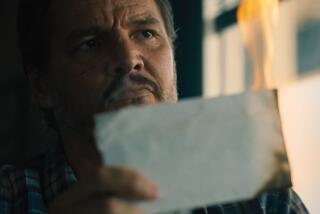Artistic expression in devastation’s wake
- Share via
In David LaChapelle’s enthralling “Rize,” Tommy Johnson explains that he was working toward his goal of becoming a big-time drug dealer in South-Central Los Angeles when he was derailed by jail time, where he underwent a religious transformation and reappraised his life. Responding to the devastation and despair of the 1992 riots and answering a friend’s plea to provide entertainment for her child’s birthday party, Johnson was reborn as Tommy the Clown.
A burly, outgoing young man, Tommy inadvertently unleashed a new dance phenomenon that he calls clowning, which in turn has given birth to an edgier, more aggressive freestyle form called krumping.
With his baggy jumpsuit, rainbow wig and whitened face embellished with tiny red balloon designs, Tommy looks like a classic clown. But he discovered he is a veritable Pied Piper, reaching kids through dance, humor and affection.
Through his street performances, party entertainments, dance competitions and myriad related activities, Tommy has laid the foundation for an alternative to gang life for countless young people.
Having achieved success as a photographer, music video and commercials director and as director and designer of Elton John’s “The Red Piano” show at Caesars Palace, LaChapelle now reveals he has the documentary filmmaker’s gift for charting the evolution of a new form of artistic expression as a way of illuminating an entire world, that of South-Central Los Angeles, where people of goodwill continue to form a warm, mutually supportive community in the face of the omnipresent dangers of drive-by gang shootings.
With Tommy as the film’s anchor, “Rize” focuses considerable attention on the krumpers, especially the dynamic Dragon and the commanding Ms. Prissy. While Tommy is an entertainer, Dragon and his friends are attempting to connect intuitively with their tribal roots, to create identity and pride through an artistic expression that diffuses anger and frustration and transforms them into art.
The spontaneity and energy with which the clowns and krumpers perform is breathtaking, and at one point LaChapelle intercuts a krumpers’ performance with footage shot by Leni Riefenstahl of the ritual, often combative dances of Nuba tribesmen. The effect is startling in the similarities, although the designs the krumpers paint on their faces owe more inspiration to graffiti art than traditional African motifs.
Throughout the film, there is the sense of individuals reaching deep within themselves to find ways of expression that will give meaning to their lives. The original music from Red Ronin Productions and Amy Marie Beauchamp and Jose Cancella’s original score complement the tremendous wit, vitality and sensuality of the dancers.
Dragon, born Jason Green, and his friends distance themselves from the commercial world of hip-hop and emphasize the purity of expression. Yet so dazzling are he, Ms. Prissy -- Marquisa Gardner is her real name -- and others that it’s difficult to imagine that “Rize” is not bringing them unprecedented attention and opportunities. LaChapelle could well be already thinking of catching up with these engaging people several years from now.
*
‘Rize’
MPAA rating: PG-13 for suggestive content, drug references, language and brief nudity
Times guidelines: Nonexploitative depiction of the realities of life in South-Central Los Angeles with an emphasis on the positive makes this film suitable family fare.
A Lions Gate Films release. Director David LaChapelle. Producers LaChapelle, Marc Hawker, Ellen Jacobson-Clarke, Richmond Talauega, Tone Talauega. Cinematographer Morgan Susser. Editor Fernando Villena. Original music Red Ronin Productions. Original score Amy Marie Beauchamp and Jose Cancella. Running time: 1 hour, 27 minutes.
In general release.
More to Read
The biggest entertainment stories
Get our big stories about Hollywood, film, television, music, arts, culture and more right in your inbox as soon as they publish.
You may occasionally receive promotional content from the Los Angeles Times.










